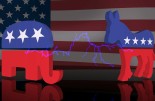Natixis IM: Commentary on US elections and outlook for US market
Natixis IM: Commentary on US elections and outlook for US market

Garrett Melson, Portfolio Strategist, at Natixis Investment Managers, comments on the US elections and the outlook for the US market.
In the wake of both the first presidential debate markets have quickly moved to price in a Trump victory, rolling out a playbook much akin to Trump’s first term, a trade that only accelerated in the wake of the assassination attempt with investors increasingly expecting not only a Trump win, but a red sweep of Congress as well.
Until this week we’ve heard very little in the way of a potential policy platform leaving investors to broadly bid up traditional energy names, deregulation and tax related beneficiaries, such as financials, cryptocurrencies, and small caps, and cyclically sensitive areas of the market that would benefit from a supposedly pro-growth agenda.
Or so the narrative goes. While investors have pointed to the steepening in the yield curve as a further example of a Trump Trade, it doesn’t pass the smell test. The steepening we’ve seen in the 2s10s has been entirely a function of the front end rallying more than the long end – a bull steepener.
More importantly, the long end has joined in on the rally with both 10Y nominal and real yields both lower than pre-debate levels. Indeed, one could argue that longer rates should have rallied more given the magnitude of the downside surprise on June CPI, but all told, rates markets don’t seem to be reflecting a higher nominal growth environment under a Trump victory as the narrative suggests.
While the market is already positioning for a Trump victory in typical front running fashion, there are a plethora of reasons to remain somewhat skeptical of the repricing. With nearly 4 months remaining until the election, an eternity for both markets and politics, there’s plenty of time for more surprises and shifts in expectations, particularly as pressure on Biden to bow out of the race ramps up yet again. And even the perceived beneficiaries investors are bidding up may not be winners under an actual Trump administration.
One need look no further than the energy complex to see a sector that intuitively should benefit from a supposedly oil friendly administration which massively underperformed under Trump’s first term. And finally, given the massive downside surprise on the June CPI print that has finally crystalized for investors that policy recalibration is imminent, there’s reason to attribute a considerable share of the repricing not just to Trump’s odds, but rather repricing of rate expectations and the effect on rate sensitive areas of the market, such as small caps.
Ultimately, while a Trump victory certainly is the odds on favorite, the repricing seems to be getting ahead of itself to a degree. Much of that repricing is speculative in nature based upon somewhat naïve assumptions of what a second Trump presidency would look like. For all the consternation around election winners and losers, historically the election effect is fairly short lived with the earnings cycle ultimately shaping market performance in the wake of the election.
So what could that look like? Well regardless of any political pressure from Trump, the Fed remains independent and data dependent, and that data and recent Fedspeak shows a recalibration of policy is imminent with the easing cycle set to commence in September with the Fed likely following a measured quarterly pace of rate reductions barring any further weakness emerging in labor markets or broader economic growth.
Trade remains a considerable wild card and one area where Trump continues to have strong convictions and flexibility to act largely unilaterally without congressional approval. Increasing tariffs on not only China but also Europe likely risks weighing on growth, both domestically and abroad. And tax cuts are of concern to the degree policy under the Tax Cuts and Jobs Act are extended and potentially new cuts unveiled.
There remain plenty of unknowns with respect to actual winners and losers as well as the broader fiscal impulse to growth. With such a consensus expectation priced into markets there’s always the risk of a buy the rumor, sell the news type dynamic. And in the interim, there’s the risk of some unwind of that optimism dependent upon polling shifts and potentially even candidate changes.
At the end of the day, political impacts on markets are typically short lived. There are indeed both upside and downside risks to consider under any election outcome, particularly a Trump victory and potential red sweep, but corporates have proven time and again their dynamism and ability adapt, suggesting investors should have confidence in markets’ ability to shake off any short term impacts of election developments as the underlying fundamental economic backdrop remains constructive.








